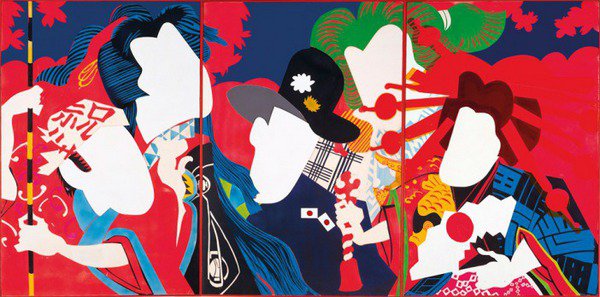The EY Exhibition
dal 13/9/2015 al 23/1/2016
Segnalato da
13/9/2015
The EY Exhibition
Tate Modern, London
The World Goes Pop. The exhibition revealing how artists around the world engaged with the spirit of Pop, from Latin America to Asia, and from Europe to the Middle East. Around 160 works from the 1960s and 1970s will be brought together.

The EY Exhibition: The World Goes Pop is a groundbreaking exhibition revealing how artists around the world engaged with the spirit of Pop, from Latin America to Asia, and from Europe to the Middle East. At Tate Modern from17 September 2015, the show will explode the traditional story of Pop art and show how different cultures contributed, re-thought and responded to the movement. Around 160 works from the 1960s and 1970s will be brought together, including many which have never been exhibited in the UK before.
Pop art is generally considered an Anglo-American phenomenon, a knowing but unconflicted reflection on modern commercial culture, associated with such artists as Andy Warhol and Roy Lichtenstein. This exhibition will reveal the alternative stories of Pop, highlighting key figures of the era who have often been left out of mainstream art history. It will also reveal how Pop was never just a celebration of Western consumerism, but was often a subversive international language for criticism and public protest across the globe.
Reacting to the market and media dominance of post-war America, Pop art arose in many countries and communities as an overtly political, destabilising force. The EY Exhibition: The World Goes Pop will show how artists used this visual language to critique its capitalist origins while benefiting from its mass appeal and graphic power. The exhibition will include the Austrian Kiki Kogelnik’s anti-war sculpture Bombs in Love 1962, and the subverted commercial logos painted by Boris Bućan in Croatia.
Pop’s comic-book blondes and advertising models have become familiar images of the idealised female body, but this exhibition will also reveal the many women artists who presented alternative visions. The Pop body could be complex and visceral instead, from Brazilian Anna María Maiolino’s brightly coloured sculpture of digestive organs Glu, Glu, Glu 1966, to the paintings of cut-up and isolated body parts by Slovakia’s Jana Želibská and Argentina’s Delia Cancela. The EY Exhibition: The World Goes Pop will also showcase many other women artists who played key roles in the movement, including Evelyne Axell, Eulàlia Grau, Nicola L,Marta Minujin and Martha Rosler, challenging the traditional cast of male figures who have come to dominate Pop’s canon.
Pop art is also traditionally associated with the hyper-individualised consumer and the isolated celebrity icon, but global Pop artists often found the amassed crowd to be a more potent symbol of contemporary culture. Icelandic artist Erró’s American Interiors 1968 showed throngs of Chinese workers invading domestic Western scenes, while Brazilian Claudio Tozzi’s Multitude 1968 and Spanish-based Equipo Crónica’s Concentration or Quantity Becomes Quality 1966 showed the modern energy and antagonism of crowds, in sharp contrast to American Pop’s remote icons like Marilyn and Elvis. Other artists even united a Pop aesthetic with their own folk traditions, bringing together contemporary imagery with local practices. The exhibition will show many such variations from across the globe, from Judy Chicago’s decorated car hoods to Beatriz Gonzalez’s painted Colombian dining table to Ushio Shinohara’s ‘popped’ versions of 19th century Japanese prints.
The EY Exhibition: The World Goes Pop is curated by Jessica Morgan, Director, Dia Art Foundation, and Flavia Frigeri, Curator, Tate Modern, with Elsa Coustou, Assistant Curator, Tate Modern. The exhibition will be accompanied by a major new catalogue from Tate Publishing and a programme of talks and events in the gallery.
Notes to Editor
The EY Exhibition
The EY Exhibition: The World Goes Pop is part of the three-year arts partnership between EY and Tate. This follows The EY Exhibition: Paul Klee – Making Visible at Tate Modern in 2013, The EY Exhibition: Late Turner – Painting Set Free at Tate Britain in 2014, and The EY Exhibition: Sonia Delaunay which runs at Tate Modern from 15 April to 9 August 2015. The partnership helps Tate to realise its ambitious arts programme across Tate Modern and Tate Britain, with EY’s support being extended through corporate memberships at Tate Liverpool, Tate St Ives and at many of the Plus Tate partners around the country. The partnership, announced in July 2013 makes EY one of the largest corporate supporters of Tate.
Martin Cook, Managing Partner Commercial, UK & Ireland at EY, said:
“Often seen as a western, mainly American phenomenon, this extraordinary exhibition triumphantly proves Pop art was a global movement. It highlights key figures, ignored by art history as they use Pop to express their own cultures with a conscious use of commercial symbols. We are hugely proud to be supporting Tate through The EY Exhibition: The World Goes Pop as part of our EY Tate Arts Partnership. At EY, our people across the world help clients navigate and take advantage of today’s global trends. And at EY we celebrate too the talent, the diversity and the invention of our people, which in turn supports our commitment to building a better working world.”
Image: Ushio Shinohara, Doll Festival 1966. Hyogo Prefectural Museum of Art (Yamamura Collection) © Ushio and Noriko Shinohara
For further press information please contact Duncan Holden / Cecily Carbone, Tate Press Office
Call +44 (0)20 7887 4939/8731 Email pressoffice@tate.org.uk
Tate Modern
Bankside, London
Open daily from 10.00–18.00 and until 22.00 on Friday and Saturday
Last admission and ticket sales to special exhibitions is at 21.15. Ticket desks close at this time.
Adult £16.00 (without donation £14.50)
Concession £14.00 (without donation £12.70)
Help Tate by including the voluntary donation to enable Gift Aid
No booking fee on this exhibition
Under 12s go free (up to four per parent or guardian)
Family tickets available (two adults and two children 12–18 years) by telephone or in the gallery



